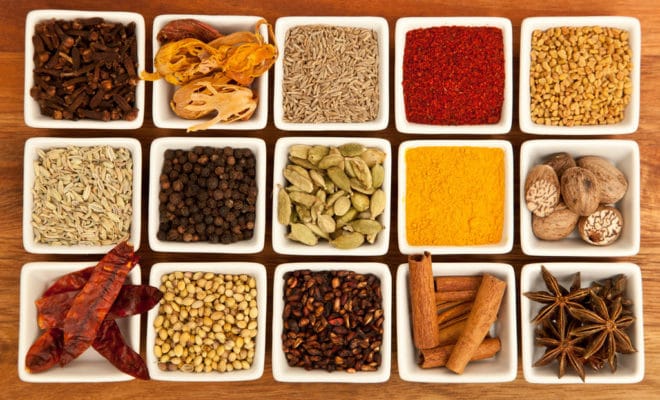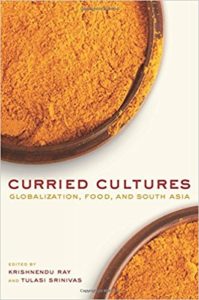Books
On a Plate: Changing Foodscape of South Asian Culture

Representational Image
Wikimedia Commons
Curried Cultures, an anthology edited by Krishnendu Ray and Tulasi Srinivas, aims to make the global audience get closer to the South Asian food trail.
Former United States President Barack Obama’s recent remark in India that he had his own recipe of dal made him a bigger star than he already was in the country.
There is, however, a lot more about South Asian cuisine that many in the world still need to get acquainted with. Armed with the belief, United States-based authors and food researchers Krishnendu Ray and Tulasi Srinivas set out to compile a collection of essays aimed to get the region’s aromatic spices their due. The result: Curried Cultures: Globalization, Food, and South Asia, a book edited by them that was released around the world recently.
The book talks about globalization, and the changing face of South Asian cuisine through various essays, each of which is from different from the other. “What I like is that each essay has a point of view, while describing rich new empirical material, that complements the other in constructing a mosaic of changing but durable practices and concerns,” Ray, an associate professor of food studies and department chair of Nutrition and Food Studies at New York University, tells Little India.

Krishnendu Ray
As editors, Srinivas, an assistant professor in the Department of Communication Studies and the Institute for Liberal Arts and Interdisciplinary Studies at Emerson College, and Ray attempted to portray the reality of South Asia as the new hub of intersecting global networks of people, processes and concepts. “The region illuminates how bodies, diets and aspirations are being pulled together and flung apart. The wide variety of regional South Asian cuisines is slowly changing the world in different ways,” adds Ray.
To understand the history of South Asian cuisine, it is important to delve into the eclectic history of the region, as they are inseparable. “World conquerors such as the Dutch, the British and the Americans are not known for their food, although their drinks are powerful — think coffee, tea and whiskey,” he says. In comparison, the reach of the French, Chinese, Japanese, Greek, Mexican and Peruvian cuisine is far greater.
It is no wonder then that it was imperative for the essays compiled by the duo to have a geographical range and historical depth. So, while one feature talks about the cosmopolitan spread served in the princely zenanas in late colonial India, another one digs into the nationalist criticism of racist English presumptions about the Indian kitchen. The chapter on fancy restaurants in contemporary Mumbai takes the reader to the reality of the present times. The essays also discuss Indian restaurants in New York, London, Boston, Berkley and Mumbai, as well as other parts of India.
Among the essays included in the book are A Different History of the Present: The Movement of Crops, Cuisines, and Globalization by Akhil Gupta, Dum Pukht: A Pseudo-Historical Cuisine by Holly Shaffer and Udupi Hotels: Entrepreneurship, Reform, and Revival by Stig Toft Madsen and Geoffrey Gardella.
“We attempted to represent a variety of perspectives, whether it was historical, geographical, cultural studies or food studies,” says Ray. So, the menu in the book includes essays on the cuisines of various erstwhile princely states across India such as Jaipur, Kapurthala, Bhopal, Kashmir, and Hyderabad. It also highlights cuisines and food trails from the modern-day Kolkata, Udupi, Lucknow, and Mumbai.

Food in South Asia is not just about throwing in a few ingredients in a pan, it is an integral part of the culture and traditions of a region. A reflection of the produce of that place, food has a strong essence of the region’s identity. To understand and relate to it from a global perspective can be challenging, Ray believes. And that is where the duo’s expertise came in.
“South Asian food is regional and that is arguably true about most cuisines of the world,” Ray says, pointing out that Western experiences of Indian food, however, have been forced within a very narrow frame of Mughlai restaurant foods. “Our attempt was to start from there — with our ironic curry title — and then take the reader elsewhere to give them a taste of the range and historical depth of Indian foods with their complex cultural politics,” he explains.
Ray and Srinivas take the readers back in time, to give them a glimpse of the history behind the aromatic spices and the rich colors of South Asian cuisine. The historical journey of Indian food is one of variety, change and resilience, Ray says, adding, “It can be argued that Indian nationalism was born in resisting English depredations of the Indian middle-class kitchen. Just as nationalism in Europe and the Americas were born in coffee houses and taverns, in South Asia it was born in defending and changing the domestic habits of the kitchen.”
The essays tell a story of how Indian foods have a long history of being local while being connected to a much wider world. “Whether it is the Roman amphoras, Central Asian tandoors, Chinese soy sauce and tea, incense-laden Middle-eastern boats, African tubers, or the southeast Asian spices and paan, Indian food is intertwined with that of many cultures in the continent,” he says. And that pattern continues even today, the only difference being that the geographical distance keeps changing.
The projection of South Asian food has changed over the years and as India slowly endeavors to comes out of its Third World status, the narrative will keep changing, feels the author. “There is a greater engagement globally with things from South Asia and this is leveraged by the 9 million or so South Asians abroad,” he adds. “Their articulation of culture is not only because they belong to it, but also because they treat it as routes of dispersal.”
Throughout history, people have moved and taken their culture and traditions along with them. “That is how newness enters the world and tradition is reinvented,” says Ray, calling Curried Cultures an “early analysis of possible gustatory futures with its many joys and burdens.”
South Asians represent a fascinating dimension of movement of cultures and people in the contemporary world, he adds. “South Asian food at home and abroad is a terrific illustration of that dynamic interaction between rootedness and mobility.”



